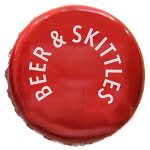Some seven centuries ago the “new” town of Winchelsea was founded by Edward I to replace an older town of the same name three miles away on the coast. Old Winchelsea was a principal harbour in the Cinque Ports Confederation but was lost to the sea in a series of great storms in the 13th century. New Winchelsea was one of the towns to be built to a plan – a grid of streets – and today it sits on a hill overlooking the now distant sea.
Its main pub, the New Inn, is so named to commemorate the new pub in the new town built in 1288. It was first licensed in the 18th century when it was a coaching inn on the road from Hastings to Rye. It was rebuilt in 1722 and its recent sign depicted a section of the street plan. However, this historically themed sign has recently been replaced with another.
By the 1950s, the New Inn had the only toilet available to the public in Winchelsea. But in the 1970s, the pub was refurbished and its toilets ceased to be available from the outside. With a large, expanding tourist trade, including thousands of visitors a year to the church opposite alone, proposals were put forward for a much needed public toilet in town. This was opposed by residents and became a contentious issue leading to a comparison being made between Winchelsea and the fictitious French town of Clochemerle, then the setting of a popular TV programme. Consequently Winchelsea became a laughing stock. But the matter was finally resolved in 1973 with the site of the present (now closed) toilet block down the road on the edge of the town (www.winchelsea.net). And, with the closure of the Bridge House Inn, the New Inn is now the only pub remaining in the town.
Sussex Express 10-1-1872
* The pubs of Rye, 1750-1950 by David Russell is available in Rye from the Heritage Centre, Strand Quay; Adams, 9 High Street, The Queen Adelaide, 23 Ferry Road, or online. Other books by David Russell are The Pubs of Hastings & St Leonards, The Swan, Hastings and Register of Licensees for Hastings & St Leonards
Photo: Lynda Russell




